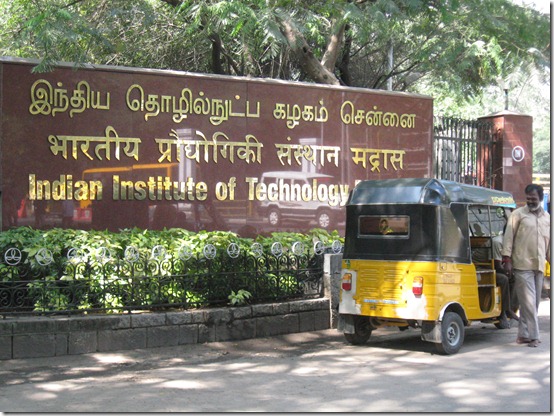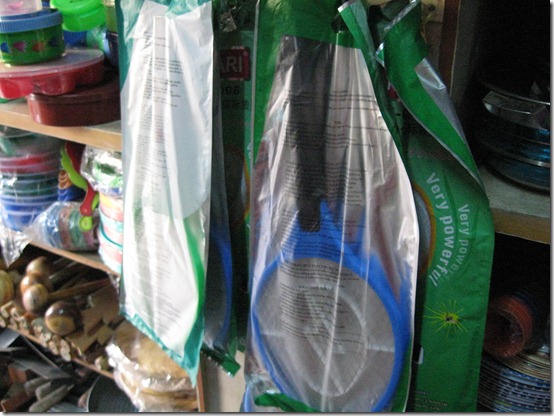Prashanth drove me through Chennai wicked morning traffic and dropped me off at IIT Madras. It almost felt like a homecoming. This institution is where I began my research in India, and seeing the Gajendra Circle elephants made the memories flood back. Plus, if you know me, then you must be conscious of my affinity for academic institutions.
I had only two Essmart appointments for the day. The first was with the Rural Technology Action Group, which is kind of like MIT’s D-Lab. The group essentially coordinates rural development technology projects between professors/labs and NGOs. Mr. Gopalakrishnan, RuTAG’s Project Consultant, has a daughter who received her PhD from MIT, so he likes to talk about Boston with me. Professor Devendra Jalihal, RuTAG’s Principal Coordinator who is also part of the Department of Electrical Engineering, has always been responsive to my inquiries as well.
During my short meeting with Mr. Gopalakrishnan, I basically asked if RuTAG technologies are currently available and if the organization would be interested in having them “transferred” through an organization/company like Essmart. Or, at least, if they would be interested in including the technologies in our catalog. Mr. Gopalakrishnan asked me to return the next day so that we can talk about the products with Professor Jalihal. Fair, I said.
The second meeting was with the Centre for Social Innovation and Entrepreneurship (CSIE). This is a new group that was organized soon after I left Chennai after the summer of 2010. Nishant Goyal and Joseph Thomas (previously of Villgro) are the Project Consultants. Nishant helps run a class taught by Professor John Bosco Lourdusamy, who was my research advisor during my first stay in Chennai (ah, the connections). Afterward, he recognized me as the “one who wrote that nice piece about Villgro Stores.” Can’t deny that one.
Joe was a fount of information and opinions. Makes sense – he’s been working in India’s rural space for 30 years. Some interesting things he pointed out:
- Social entrepreneurship isn’t being recognized in India’s academic circles. That’s ironic because “social entrepreneurship” is a buzzword in western universities, and most of them cite case studies from India. This is why I should pursue my PhD in India, says Joe.
- It’s essential to understand why products fail, not just that they fail. Failure comes from multiple sources, such as user error, mishandling, or lack of training. Most of the reasons why products “fail” are stupid, says Joe.
- For rural customers to buy into a product, the value proposition and the need have to be there. If a customer invests 1 rupee, he needs to get 5 rupees back. Microfinance is successful because there’s an obvious need with an obvious value proposition. Mobile phones work for the bottom of the pyramid for this reason, too.
- Cash flow for rural customers is key for them to buy into products/services, too. The most successful social enterprises either bring money into a rural community (e.g. rural BPOs) or retain money in a community (e.g. import substitution, but at the very local level)
I then got a rundown of some of the products we were considering starting with:
- Cooking stoves – difficult to sell because firewood is free. One way to get users is to make money off of carbon credits and pay end users to use the stove.
- Solar lanterns – have affordability and user issues. Solar-assisted might work better than fully solar. Solar lanterns are most easily commercialized if they’re financed with the correct scheme, such as a renting system.
- Water filters – always hard to disseminate because different filters are used for different contaminants and water sources.
- Drip irrigation systems – if iDE India has figured it out, then they’re probably good things. However, their functionality also depends on the type of water source
- Bug bat – lots of fun! Perhaps the best entry point of these.
Nishant and Joe then offered to consult the Essmart team, which I am grateful for. Hooray for collaborative learning! Yes, and we will do what we can to support CSIE.
After the discussion with Joe, I felt like Essmart as a team needed to begin reconsidering the types of technologies we want to sell. I had originally stayed away from large agricultural technologies, but actually, these are the types of products that bring the most immediate social impact to users yet have the most limited reach. Combining these technologies with our current sales/marketing/distribution model might take us somewhere. However, the problem with these technologies is that they are typically designed for a specific, local population. Technology transfer sometimes requires changing the technology, so there need to be human resources to do this.


